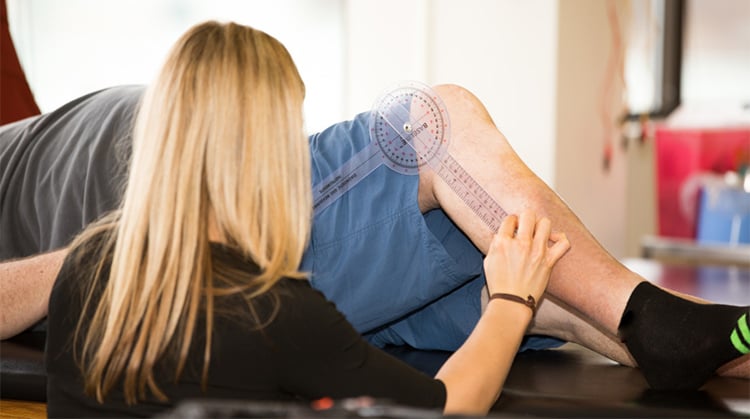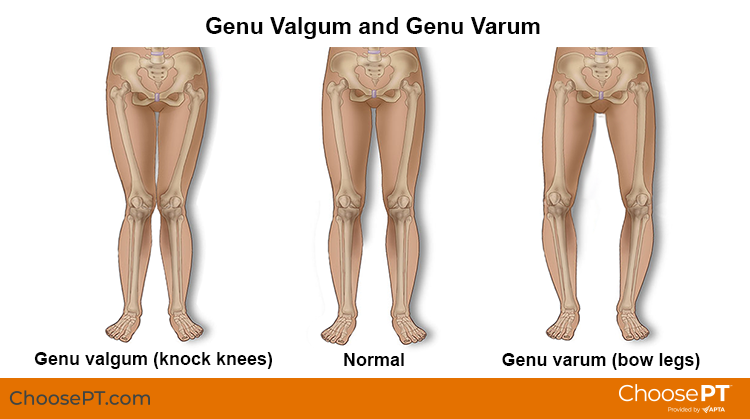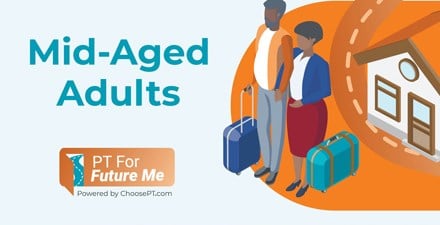Physical Therapy Guide to Knee Pain
Knee pain can result from disease, overuse injury, or trauma. Among American adults, approximately 25% have experienced knee pain that affects the function of their knee. Knee pain and conditions related to the knee are common. In runners, the knee is the part of the body that is injured most often. Changes to the knee related to aging (osteoarthritis) commonly occur in people over the age of 50. Thousands of steps, squats, and twists to the knee over a long life can cause changes to cartilage and other parts of the knee.
Knee pain also occurs in growing children. Pain can reduce their participation in physical activities, which may lead to other problems later in life. Changes in the posture of the knee as well as the lower extremity (hip, leg, and ankle) during growth can cause pain in children and teenagers. These developmental changes can affect knee function.
Knee pain can be mild, or it can be severe and sharp. Knee injuries can result from a direct blow to the knee or a sudden movement that strains the knee beyond the normal range of motion. Knee pain can make it hard to walk, rise from a chair, climb stairs, or play sports. Physical therapists are trained to diagnose and treat knee pain and to help ease your pain and restore movement. They also can work together with other members of your health care team.
Physical therapists are movement experts. They improve quality of life through hands-on care, patient education, and prescribed movement. You can contact a physical therapist directly for an evaluation. To find a physical therapist in your area, visit Find a PT.
Resource List of Related Conditions
Knee pain is a broad topic. This guide covers knee pain in general. To read more about specific conditions that are related to or cause knee pain, view the APTA Guides on these topics:
- Anterior Cruciate Ligament (ACL) Tear.
- Osteoarthritis (general).
- Blount's Disease (most common in toddlers, children, and youth).
- Discoid Meniscus (most common in children and youth.
- Hamstring Injuries.
- Iliotibial Band Syndrome (ITBS) (a common overuse injury).
- Knee Bursitis.
- Lateral Collateral Ligament (LCL) Injury.
- Lower Extremity Stress Fractures.
- Medial Collateral Ligament (MCL) Injury.
- Medial Patellofemoral Ligament (MPFL) Injury.
- Meniscal Tear.
- Osgood-Schlatter Disease (usually diagnosed in youth).
- Osteoarthritis of the Knee.
- Patellar Instability.
- Patellofemoral (Kneecap) Pain.
- Pes Anserine Bursitis.
- Plica Syndrome.
- Posterior Cruciate Ligament (PCL) Injury.
- Total Knee Replacement (Arthroplasty).
What Is Knee Pain?
The knee joint is a hinge that connects the shin bone (tibia) and the thigh bone (femur) at the knee cap (patella). Four main ligaments support the knee joint. They are the:
- Anterior cruciate ligament, or ACL.
- Posterior cruciate ligament, or PCL.
- Medial collateral ligament, or MCL.
- Lateral collateral ligament, or LCL.
Injury to any of these ligaments can cause knee pain.
Two rings of cartilage (the medial and lateral meniscus), attached to the shin bone (tibia), also act as shock absorbers for the knee. When this protective cartilage gradually wears away over time, osteoarthritis develops — causing pain and swelling in the knee. Osteoarthritis is the most common cause of knee pain.
How Does It Feel?
Knee pain can occur suddenly for no apparent reason. It also can develop slowly, as a result of repeated trauma. Knee pain occurs in different parts of the knee. Below is an overview of the types of knee pain, and the areas in which they may occur:
- Anterior knee pain. This condition is also called patellofemoral (or kneecap) pain. Pain is felt around the kneecap (patella) at the front of the knee. This type of knee pain is caused when the kneecap shifts out of position. Kneecap pain commonly affects younger females, such as athletes, and may be due to repeated movements or overuse. Pain often occurs when performing activities like squatting, walking uphill, or climbing stairs.
- Lateral knee pain. This pain occurs on the outside of the knee. It is a type of overuse injury common in runners. It happens when the tendon called the iliotibial band becomes irritated. Pain is often felt when performing activities such as climbing stairs, walking, or running.
- Medial knee pain. This pain occurs along the inside of the knee. It develops when the MCL becomes irritated due to direct injury or overuse. You may feel pain when squatting, walking up or down a hill or ramp, or going down stairs.
- Pain caused by a ligament tear. This type of pain may result from a direct blow to the knee. It also can occur if you twist or pivot your knee while your foot is planted on the ground. Instant pain and swelling usually occur. The knee may feel unstable — like it will give out — when you try to put weight on your leg.
- Pain caused by osteoarthritis, or OA. This type of pain may occur anywhere in the knee where cartilage has broken down. It may begin as mild and gradually get worse. Over time, the pain can begin to limit your ability to fully bend and straighten your knee, climb stairs, squat, or lower yourself to sit in a chair. The knee also may swell, off and on, with increased activity. OA can make it more and more difficult to walk long distances.
How Is It Diagnosed?
Your physical therapist will perform an initial evaluation. The goals are to assess the condition of your knee and to determine the cause(s) of your pain. They will ask you questions about your medical history and your current condition, such as:
- How did your injury occur?
- Were there previous injuries to your knee earlier in your life?
- What are your current symptoms? How have they affected your daily activities?
- Where is your pain located? How intense is your pain? Does your pain vary during the day?
- Are there any activities that you are unable to do? Is it hard for you to complete any activities due to your injury?
- How have you taken care of your knee condition so far? Have you seen other health care providers or had imaging tests (X-ray or MRI)? What are the results of any tests that you have had?
Activities that aggravate your symptoms will be noted as well as any ways that help you reduce your symptoms. Some patients have difficulty with activities at work or with activities such as shopping, cooking, and walking. More active patients may have symptoms during higher levels of activity, like running or other sports. Pain may cause them to stop their desired activity.
Gathering this information allows your physical therapist to understand your condition better. It will help them determine the course of a physical examination, which will include various tests and measures.
Physical examinations vary. Most often, they begin by observing any movements that cause the problems discussed in your interview. Your physical examination will include the area of your pain. It also will include other areas of your body that may have changed or been forced to overwork, including your:
- Low back.
- Hip.
- Thigh.
- Ankle.
- Foot.
Your physical therapist may watch how you walk, use the stairs, squat, and balance on one leg. They will assess the movement and strength of your knee and other regions of your trunk and lower extremity. This will help them determine which areas of your body require treatment to improve your knee condition. Your physical therapist also will gently, but skillfully, press the front, side, and back of your knee, and other areas to find where it is most painful.
The tests your physical therapist does will help them find out if you have:
- Limited range of motion in your knee.
- Pain in your knee with specific movements.
- Weakness in the muscles around your hip, knee, or ankle.
- Limited flexibility in your hip, knee, or ankle.
- Difficulty walking.
- Difficulty performing activities, such as rising from a chair or climbing stairs.
- Problems with your balance or coordination.
- Difficulty controlling your knee during certain activities.
- Difficulty performing specific sports activities (for athletes).
After your interview and physical examination, your physical therapist will discuss their findings with you. They will work with you to develop a program that begins your recovery. Your program may include the treatment techniques listed in the next section.
How Can a Physical Therapist Help?

Your physical therapist will develop a personalized rehabilitation program for your condition. This program can help you safely return to your desired activities. Some general treatment techniques may include:
- Patient education. Your physical therapist will work with you to identify and change any factors causing your pain. They will work with you on the type and amount of exercise you do, your athletic activities, and your footwear. They will recommend improvements to your daily activities. Your physical therapist will develop and teach you a personalized exercise program to help you return to your desired activities as much as possible.
- Pain management. Your physical therapist will design a program to address your pain that includes applying ice to the affected area. They also may recommend modifying some activities that cause pain. Your physical therapist will use and teach you pain-management techniques to reduce or eliminate the need for medication, including opioids.
- Range-of-motion exercise. If the mobility (movement) of your knee is limited, it can cause increased stress on your knee. Lack of movement in your hip, foot, or ankle also may be forcing your knee to work at a disadvantage. Your physical therapist may teach you stretching techniques to decrease tension and help restore the normal motion of your joints. These will focus on joints from the pelvis/hip region down to your foot.
- Manual therapy. Your physical therapist may treat your condition by applying hands-on treatments (manual therapy) to gently move your muscles and joints. These techniques help to restore and improve proper motion. They also may be used to guide your joints into a less stressful movement pattern. Your physical therapist may provide gentle resistance as you perform certain movements, to improve your strength.
- Muscle strengthening. Muscle weaknesses or imbalances can cause some knee conditions and continued symptoms. Based on your specific condition, your physical therapist will design a safe resistance program for you. This program likely will include exercises to strengthen your core (midsection) and your lower extremities. They may begin your program with exercises done while lying on a table, bed, or the floor. You then may advance to exercises done in a standing position (e.g., standing squats). Your physical therapist will choose what exercises are right for you based on your age and physical condition. They may have you use resistance machines in the clinic, and advise you on what equipment to use at home or at the gym.
- Functional training. Once your pain, strength, and motion improve you will need to safely and slowly return to more demanding activities. It is essential to learn safe, controlled movements so you can minimize the stress on your knee. Based on your unique condition and goals, your physical therapist will provide you with a series of activities to help you use and move your body correctly and safely.
- Braces and other assistive devices. Depending on your condition, your physical therapist or other members of the health care team may recommend braces, walking aides, wraps, or tape. These devices may assist in your recovery.
- A cane, walker, or crutches can help reduce your pain and improve your ability to walk. Your physical therapist may recommend that you use these walking aids for a short time. Or, if you have specific conditions, such as osteoarthritis, you may need to use them longer.
- Your physical therapist may recommend a brace to stabilize your knee during the initial recovery phase. They can assist you with fitting the brace and teach you how to use it.
- Wrapping your knee to reduce swelling may be recommended. Your physical therapist will use specific wrapping techniques. They also may recommend the use of compression stockings.
Your physical therapist may refer you to an orthopedic doctor who specializes in knee conditions and injuries. They may recommend diagnostic imaging (such as an X-ray or MRI). An X-ray helps to identify bone abnormalities (such as osteoarthritis or fractures). An MRI will help confirm the diagnosis of tendon and ligament injuries and provide a different view of your bones and cartilage.
How Can a Physical Therapist Help Before and After Surgery?
Your physical therapist, working together with your surgeon, will be able to tell you how much activity you can do. Activities allowed will depend on the type of knee surgery (such as total knee replacement) you undergo. Your physical therapist and surgeon also may recommend physical therapy before surgery to increase your strength and motion. Physical therapy before surgery can sometimes help with recovery following surgery.
After surgery, your physical therapist will design a personalized rehabilitation program for you. They will help you regain the strength, movement, and endurance you need to return to the daily activities that you did before.
Can This Injury or Condition Be Prevented?
Knee pain may result from an injury or trauma that is out of your control. Health conditions, such as knock knees (genu valgum) or bow legs (genu varum), also can cause knee pain.

However, healthy individuals can help prevent knee pain by maintaining a healthy lifestyle that includes:
- Taking part in regular, safe physical activity.
- Getting adequate rest.
- Eating healthy foods.
Weight management also is vital for maintaining healthy knee function. Excess body weight puts extra pressure on all joints, including your knees. Ideally, people of all ages should perform regular exercises to maintain flexibility, strength, balance, and endurance. A physical therapist can design an effective exercise program to match your specific condition and goals.
It also is important for athletes to perform appropriate warmup exercises before beginning any physical activity, and to stretch regularly. Physical therapists can guide athletes to safely achieve and maintain their highest performance levels.
CAUTION: If any exercise or activity causes you knee pain, contact a doctor or physical therapist before your symptoms worsen.
What Kind of Physical Therapist Do I Need?
All physical therapists are prepared through education and experience to treat knee pain. However, you may want to consider:
- A physical therapist who is experienced in treating people with knee pain. Some physical therapists have a practice with an orthopedic and sports focus.
- A physical therapist who is a board-certified clinical specialist or who completed a residency or fellowship in orthopedic, manual, or sports physical therapy. This physical therapist has advanced knowledge, experience, and skills that may apply to your condition.
You can find physical therapists who have these and other credentials by using Find a PT, the online tool built by the American Physical Therapy Association to help you search for physical therapists with specific clinical expertise in your geographic area.
General tips when you're looking for a physical therapist (or any other health care provider):
- Get recommendations from family, friends, or other health care providers.
- When you contact a physical therapy clinic for an appointment, ask about the physical therapists' experience in helping people who have knee pain.
- Be prepared to describe your symptoms in as much detail as possible, and say what makes your symptoms worse.
The American Physical Therapy Association believes that consumers should have access to information that could help them make health care decisions and prepare them for a visit with their health care provider.
The following articles provide some of the best scientific evidence related to physical therapy treatment of knee pain. The articles report recent research and give an overview of the standards of practice both in the United States and internationally. The articles link to a PubMed* abstract which may include free full text, so that you can read it or print out a copy to bring with you to your health care provider.
Kraus VB, Sprow K, Powell KE, et al. Effects of physical activity in knee and hip osteoarthritis: a systematic umbrella review. Med Sci Sports Exerc. 2019;51(6):1324–1339. Article Summary in PubMed.
Walsh NE, Pearson J, Healey E. Physiotherapy management of lower limb osteoarthritis. Br Med Bull. 2017;122(1):151–161. Article summary in PubMed.
Nyland J, Mattocks A, Kibbe S, et al. Anterior cruciate ligament reconstruction, rehabilitation, and return to play: 2015 update. Open Access J Sports Med. 2016;7:21–32. Article summary in PubMed .
Sihvonen R, Paavola M, Maimivaara A, et al. Arthroscopic partial meniscectomy versus sham surgery for a degenerative meniscal tear. New Engl J Med. 2013;369(26):2515–2524. Article summary in PubMed .
Salacinski AJ, Krohn K, Lewis SL, et al. The effects of group cycling on gait and pain-related disability in individuals with mild-to-moderate knee osteoarthritis: a randomized controlled trial. J Orthop Sports Phys Ther. 2012;42(12):985–995. Article Summary in PubMed.
Roush JR, Bay RC. Prevalence of anterior knee pain in 18-35-year-old females. Int J Sports Phys Ther. 2012;7(4):396–401. Article summary in PubMed .
Lee SP, Souza RB, Powers CM. The influence of hip abductor muscle performance on dynamic postural stability in females with patellofemoral pain. Gait Posture. 2012;36(3):425–429. Article Summary in PubMed .
*PubMed is a free online resource developed by the National Center for Biotechnology Information. PubMed contains millions of citations to biomedical literature, including citations in the National Library of Medicine's MEDLINE database.
Expert Review:
Sep 21, 2020
Revised:
Sep 21, 2020
Content Type: Guide
Knee Pain
PT, DPT
Stephen F. Reischl
PT, DPT, board-certified clinical specialist in orthopaedic physical therapy, on behalf of the Academy of Orthopaedic Physical Therapy
Daniel Farwell
PT, DPT, board-certified clinical specialist in sports physical therapy
You Might Also Like...
Article
Why Physical Therapy Matters in Older AdulthoodSep 24, 2025
Physical therapy helps improve function, encourage activity, and prevent injuries — empowering older adults to maintain independence and a high quality
Article
Why Physical Therapy Matters in Middle AdulthoodSep 24, 2025
Physical therapy helps people in middle adulthood stay strong and active so they can keep living the life they’ve built.
Health Tips
5 Exercises to Reduce Knee PainJun 14, 2024
Knee pain is one of the most common reasons people seek medical treatment. Without proper treatment, it can linger for years. Physical therapy is e


